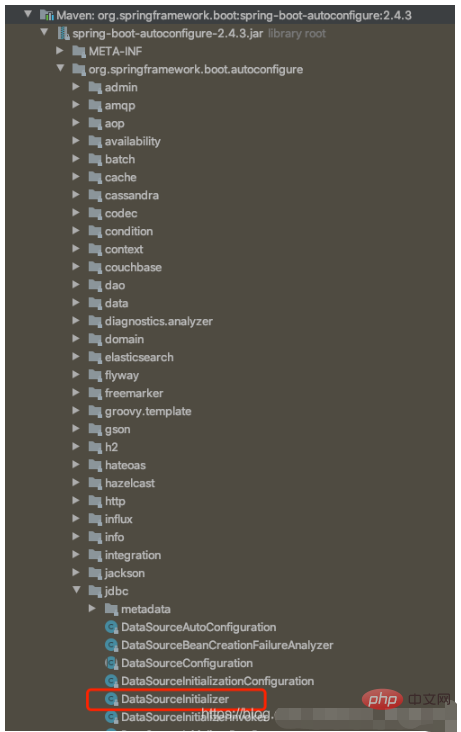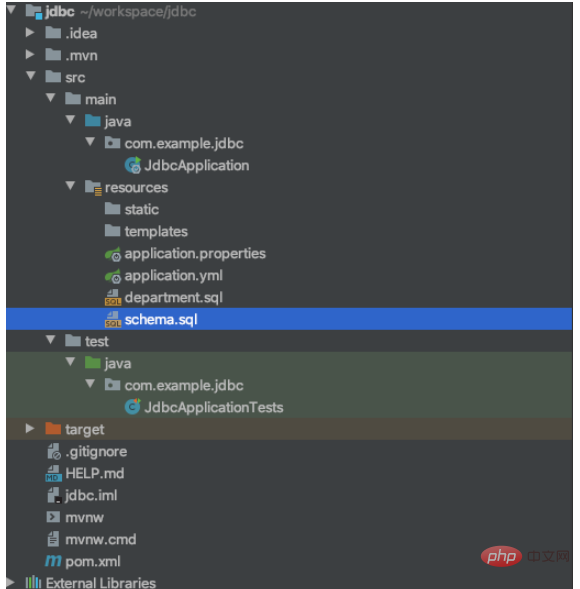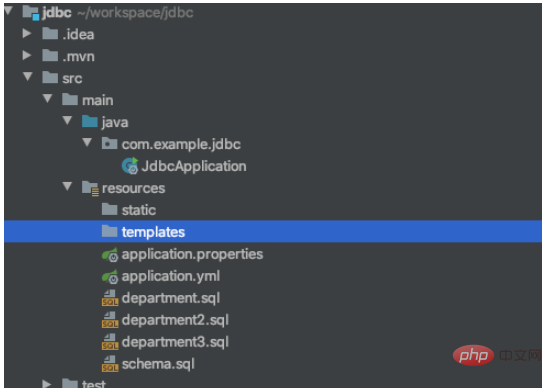SpringBoot如何启动并初始化执行sql脚本
SpringBoot启动并初始化执行sql脚本
如果我们想在项目启动的时候去执行一些sql脚本该怎么办呢,SpringBoot给我们提供了这个功能,可以在启动SpringBoot的项目时,执行脚本,下面我们来看一下。
我们先看一下源码

boolean createSchema() {
//会从application.properties或application.yml中获取sql脚本列表
List<Resource> scripts = this.getScripts("spring.datasource.schema", this.properties.getSchema(), "schema");
if (!scripts.isEmpty()) {
if (!this.isEnabled()) {
logger.debug("Initialization disabled (not running DDL scripts)");
return false;
}
String username = this.properties.getSchemaUsername();
String password = this.properties.getSchemaPassword();
//运行sql脚本
this.runScripts(scripts, username, password);
}
return !scripts.isEmpty();
}
private List<Resource> getScripts(String propertyName, List<String> resources, String fallback) {
if (resources != null) {
//如果配置文件中配置,则加载配置文件
return this.getResources(propertyName, resources, true);
} else {
//指定schema要使用的Platform(mysql、oracle),默认为all
String platform = this.properties.getPlatform();
List<String> fallbackResources = new ArrayList();
//如果配置文件中没配置,则会去类路径下找名称为schema或schema-platform的文件
fallbackResources.add("classpath*:" + fallback + "-" + platform + ".sql");
fallbackResources.add("classpath*:" + fallback + ".sql");
return this.getResources(propertyName, fallbackResources, false);
}
}
private List<Resource> getResources(String propertyName, List<String> locations, boolean validate) {
List<Resource> resources = new ArrayList();
Iterator var5 = locations.iterator();
while(var5.hasNext()) {
String location = (String)var5.next();
Resource[] var7 = this.doGetResources(location);
int var8 = var7.length;
for(int var9 = 0; var9 < var8; ++var9) {
Resource resource = var7[var9];
//验证文件是否存在
if (resource.exists()) {
resources.add(resource);
} else if (validate) {
throw new InvalidConfigurationPropertyValueException(propertyName, resource, "The specified resource does not exist.");
}
}
}
return resources;
}从源码观察,大致知道是什么意思了,SpringBoot默认会从类路径下去找脚本文件,但是类路径下只能放规定名称为schema或schema-platform的脚本文件,如果我们想要分好多个脚本文件,那么这种方式就不合适了,那么就需要我们在application.properties或application.yml中去配置脚本列表,那么这个初始化脚本操作能不能在配置文件中控制呢,可以的,有一个initialization-mode属性,可以设置三个值,always为始终执行初始化,embedded只初始化内存数据库(默认值),如h3等,never为不执行初始化。
spring:
datasource:
username: root
password: liuzhenyu199577
url: jdbc:mysql://localhost:3306/jdbc
driver-class-name: com.mysql.cj.jdbc.Driver
initialization-mode: always下面我们验证一下这两种方式
1.默认放置schema或schema-platform的脚本文件

CREATE TABLE IF NOT EXISTS department (ID VARCHAR(40) NOT NULL, NAME VARCHAR(100), PRIMARY KEY (ID));
查看数据库没有department这个表,接下来我们启动程序

启动之后,我们再看一下,就执行了

2.配置文件中指定多个sql脚本
spring:
datasource:
username: root
password: liuzhenyu199577
url: jdbc:mysql://localhost:3306/jdbc
driver-class-name: com.mysql.cj.jdbc.Driver
initialization-mode: always
schema:
- classpath:department.sql
- classpath:department2.sql
- classpath:department3.sql
三个sql脚本都是插入语句
INSERT INTO department (ID,NAME) VALUES ('1','2') INSERT INTO department (ID,NAME) VALUES ('2','3') INSERT INTO department (ID,NAME) VALUES ('3','4')
现在表中无任何数据,接下来我们启动程序

启动之后,我们再看一下,表中就有了三条数据

就是SpringBoot启动并初始化sql脚本的步骤
SpringBoot项目在启动时执行指定sql文件
1. 启动时执行
当有在项目启动时先执行指定的sql语句的需求时,可以在resources文件夹下添加需要执行的sql文件,文件中的sql语句可以是DDL脚本或DML脚本,然后在配置加入相应的配置即可,如下:
spring:
datasource:
schema: classpath:schema.sql # schema.sql中一般存放的是DDL脚本,即通常为创建或更新库表的脚本 data: classpath:data.sql # data.sql中一般是DML脚本,即通常为数据插入脚本2. 执行多个sql文件
spring.datasource.schema和spring.datasource.data都是支持接收一个列表,所以当需要执行多个sql文件时,可以使用如下配置:
spring:
datasource:
schema: classpath:schema_1.sql, classpath:schema_2.sql data: classpath:data_1.sql, classpath:data_2.sql 或 spring: datasource: schema: - classpath:schema_1.sql - classpath:schema_2.sql data: - classpath:data_1.sql - classpath:data_2.sql3. 不同运行环境执行不同脚本
一般情况下,都会有多个运行环境,比如开发、测试、生产等。而不同运行环境通常需要执行的sql会有所不同。为解决这个问题,可以使用通配符来实现。
创建不同环境的文件夹
在resources文件夹创建不同环境对应的文件夹,如dev/、sit/、prod/。
配置
application.yml
spring:
datasource:
schema: classpath:${spring.profiles.active:dev}/schema.sql
data: classpath:${spring.profiles.active:dev}/data.sql注:${}通配符支持缺省值。如上面的配置中的${spring.profiles.active:dev},其中分号前是取属性spring.profiles.active的值,而当该属性的值不存在,则使用分号后面的值,即dev。
bootstrap.yml
spring:
profiles:
active: dev # dev/sit/prod等。分别对应开发、测试、生产等不同运行环境。提醒:spring.profiles.active属性一般在bootstrap.yml或bootstrap.properties中配置。
4. 支持不同数据库
因为不同数据库的语法有所差异,所以要实现同样的功能,不同数据库的sql语句可能会不一样,所以可能会有多份不同的sql文件。当需要支持不同数据库时,可以使用如下配置:
spring:
datasource:
schema: classpath:${spring.profiles.active:dev}/schema-${spring.datasource.platform}.sql
data: classpath:${spring.profiles.active:dev}/data-${spring.datasource.platform}.sql
platform: mysql提醒:platform属性的默认值是'all',所以当有在不同数据库切换的情况下才使用如上配置,因为默认值的情况下,spring boot会自动检测当前使用的数据库。
注:此时,以dev允许环境为例,resources/dev/文件夹下必须存在如下文件:schema-mysql.sql和data-mysql.sql。
5. 避坑
5.1 坑
当在执行的sql文件中存在存储过程或函数时,在启动项目时会报错。
比如现在有这样的需求:项目启动时,扫描某张表,当表记录数为0时,插入多条记录;大于0时,跳过。
schema.sql文件脚本如下:
-- 当存储过程`p1`存在时,删除。 drop procedure if exists p1; -- 创建存储过程`p1` create procedure p1() begin declare row_num int; select count(*) into row_num from `t_user`; if row_num = 0 then INSERT INTO `t_user`(`username`, `password`) VALUES ('zhangsan', '123456'); end if; end; -- 调用存储过程`p1` call p1(); drop procedure if exists p1;
启动项目,报错,原因如下:
Caused by: com.mysql.jdbc.exceptions.jdbc4.MySQLSyntaxErrorException: You have an error in your SQL syntax; check the manual that corresponds to your MySQL server version for the right syntax to use near 'create procedure p1() begin declare row_num int' at line 1
大致的意思是:'create procedure p1() begin declare row_num int'这一句出现语法错误。刚看到这一句,我一开始是懵逼的,吓得我赶紧去比对mysql存储过程的写法,对了好久都发现没错,最后看到一篇讲解spring boot配置启动时执行sql脚本的文章,发现其中多了一项配置:spring.datasource.separator=$$。然后看源码发现,spring boot在解析sql脚本时,默认是以';'作为断句的分隔符的。看到这里,不难看出报错的原因,即:spring boot把'create procedure p1() begin declare row_num int'当成是一条普通的sql语句。而我们需要的是创建一个存储过程。
5.2 解决方案
修改sql脚本的断句分隔符。如:spring.datasource.separator=$$。然后把脚本改成:
-- 当存储过程`p1`存在时,删除。 drop procedure if exists p1;$$ -- 创建存储过程`p1` create procedure p1() begin declare row_num int; select count(*) into row_num from `t_user`; if row_num = 0 then INSERT INTO `t_user`(`username`, `password`) VALUES ('zhangsan', '123456'); end if; end;$$ -- 调用存储过程`p1` call p1();$$ drop procedure if exists p1;$$
5.3 不足
因为sql脚本的断句分隔符从';'变成'$$',所以可能需要在DDL、DML语句的';'后加'$$',不然可能会出现将整个脚本当成一条sql语句来执行的情况。比如:
-- DDL CREATE TABLE `table_name` ( -- 字段定义 ... ) ENGINE=InnoDB DEFAULT CHARSET=utf8mb4;$$ -- DML INSERT INTO `table_name` VALUE(...);$$
以上是SpringBoot如何启动并初始化执行sql脚本的详细内容。更多信息请关注PHP中文网其他相关文章!

热AI工具

Undresser.AI Undress
人工智能驱动的应用程序,用于创建逼真的裸体照片

AI Clothes Remover
用于从照片中去除衣服的在线人工智能工具。

Undress AI Tool
免费脱衣服图片

Clothoff.io
AI脱衣机

AI Hentai Generator
免费生成ai无尽的。

热门文章

热工具

记事本++7.3.1
好用且免费的代码编辑器

SublimeText3汉化版
中文版,非常好用

禅工作室 13.0.1
功能强大的PHP集成开发环境

Dreamweaver CS6
视觉化网页开发工具

SublimeText3 Mac版
神级代码编辑软件(SublimeText3)

热门话题
 Hibernate 框架中 HQL 和 SQL 的区别是什么?
Apr 17, 2024 pm 02:57 PM
Hibernate 框架中 HQL 和 SQL 的区别是什么?
Apr 17, 2024 pm 02:57 PM
HQL和SQL在Hibernate框架中进行比较:HQL(1.面向对象语法,2.数据库无关的查询,3.类型安全),而SQL直接操作数据库(1.与数据库无关的标准,2.可执行复杂查询和数据操作)。
 Oracle SQL中除法运算的用法
Mar 10, 2024 pm 03:06 PM
Oracle SQL中除法运算的用法
Mar 10, 2024 pm 03:06 PM
《OracleSQL中除法运算的用法》在OracleSQL中,除法运算是常见的数学运算之一。在数据查询和处理过程中,除法运算可以帮助我们计算字段之间的比例或者得出特定数值的逻辑关系。本文将介绍OracleSQL中除法运算的用法,并提供具体的代码示例。一、OracleSQL中除法运算的两种方式在OracleSQL中,除法运算可以使用两种不同的方式进行
 Oracle和DB2的SQL语法比较与区别
Mar 11, 2024 pm 12:09 PM
Oracle和DB2的SQL语法比较与区别
Mar 11, 2024 pm 12:09 PM
Oracle和DB2是两个常用的关系型数据库管理系统,它们都有自己独特的SQL语法和特点。本文将针对Oracle和DB2的SQL语法进行比较与区别,并提供具体的代码示例。数据库连接在Oracle中,使用以下语句连接数据库:CONNECTusername/password@database而在DB2中,连接数据库的语句如下:CONNECTTOdataba
 详解MyBatis动态SQL标签中的Set标签功能
Feb 26, 2024 pm 07:48 PM
详解MyBatis动态SQL标签中的Set标签功能
Feb 26, 2024 pm 07:48 PM
MyBatis动态SQL标签解读:Set标签用法详解MyBatis是一个优秀的持久层框架,它提供了丰富的动态SQL标签,可以灵活地构建数据库操作语句。其中,Set标签是用于生成UPDATE语句中SET子句的标签,在更新操作中非常常用。本文将详细解读MyBatis中Set标签的用法,以及通过具体的代码示例来演示其功能。什么是Set标签Set标签用于MyBati
 SQL中的identity属性是什么意思?
Feb 19, 2024 am 11:24 AM
SQL中的identity属性是什么意思?
Feb 19, 2024 am 11:24 AM
SQL中的Identity是什么,需要具体代码示例在SQL中,Identity是一种用于生成自增数字的特殊数据类型,它常用于唯一标识表中的每一行数据。Identity列通常与主键列配合使用,可以确保每条记录都有一个独一无二的标识符。本文将详细介绍Identity的使用方式以及一些实际的代码示例。Identity的基本使用方式在创建表时,可以使用Identit
 SpringBoot与SpringMVC的比较及差别分析
Dec 29, 2023 am 11:02 AM
SpringBoot与SpringMVC的比较及差别分析
Dec 29, 2023 am 11:02 AM
SpringBoot和SpringMVC都是Java开发中常用的框架,但它们之间有一些明显的差异。本文将探究这两个框架的特点和用途,并对它们的差异进行比较。首先,我们来了解一下SpringBoot。SpringBoot是由Pivotal团队开发的,它旨在简化基于Spring框架的应用程序的创建和部署。它提供了一种快速、轻量级的方式来构建独立的、可执行
 如何使用SQL语句在MySQL中进行数据聚合和统计?
Dec 17, 2023 am 08:41 AM
如何使用SQL语句在MySQL中进行数据聚合和统计?
Dec 17, 2023 am 08:41 AM
如何使用SQL语句在MySQL中进行数据聚合和统计?在进行数据分析和统计时,数据聚合和统计是非常重要的步骤。MySQL作为一个功能强大的关系型数据库管理系统,提供了丰富的聚合和统计函数,可以很方便地进行数据聚合和统计操作。本文将介绍使用SQL语句在MySQL中进行数据聚合和统计的方法,并提供具体的代码示例。一、使用COUNT函数进行计数COUNT函数是最常用
 SQL出现5120错误怎么解决
Mar 06, 2024 pm 04:33 PM
SQL出现5120错误怎么解决
Mar 06, 2024 pm 04:33 PM
解决办法:1、检查登录用户是否具有足够的权限来访问或操作该数据库,确保该用户具有正确的权限;2、检查SQL Server服务的帐户是否具有访问指定文件或文件夹的权限,确保该帐户具有足够的权限来读取和写入该文件或文件夹;3、检查指定的数据库文件是否已被其他进程打开或锁定,尝试关闭或释放该文件,并重新运行查询;4、尝试以管理员身份运行Management Studio等等。






